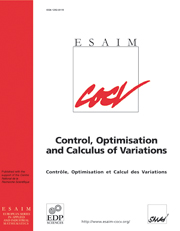Article contents
How humans fly
Published online by Cambridge University Press: 03 June 2013
Abstract
This paper is devoted to the general problem of reconstructing the cost from the observation of trajectories, in a problem of optimal control. It is motivated by the following applied problem, concerning HALE drones: one would like them to decide by themselves for their trajectories, and to behave at least as a good human pilot. This applied question is very similar to the problem of determining what is minimized in human locomotion. These starting points are the reasons for the particular classes of control systems and of costs under consideration. To summarize, our conclusion is that in general, inside these classes, three experiments visiting the same values of the control are needed to reconstruct the cost, and two experiments are in general not enough. The method is constructive.
The proof of these results is mostly based upon the Thom’s transversality theory.
This study is partly supported by FUI AAP9 project SHARE, and by ANR Project GCM, program “blanche”, project number NT09-504490.
- Type
- Research Article
- Information
- ESAIM: Control, Optimisation and Calculus of Variations , Volume 19 , Issue 4 , October 2013 , pp. 1030 - 1054
- Copyright
- © EDP Sciences, SMAI, 2013
References
- 9
- Cited by




